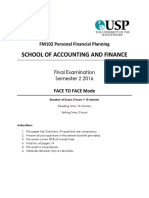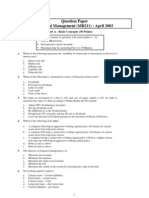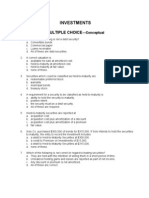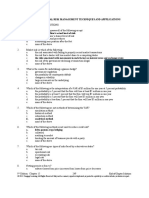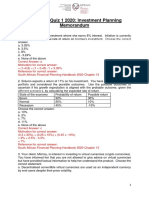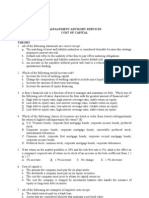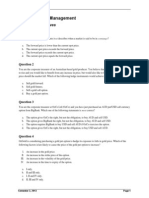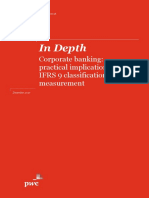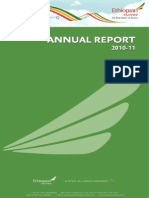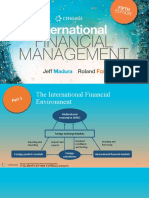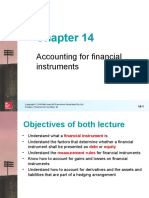Financial Risk Management: Module 7 Accounting For Derivatives and Hedge Relationships
Financial Risk Management: Module 7 Accounting For Derivatives and Hedge Relationships
Uploaded by
Chuck YintCopyright:
Available Formats
Financial Risk Management: Module 7 Accounting For Derivatives and Hedge Relationships
Financial Risk Management: Module 7 Accounting For Derivatives and Hedge Relationships
Uploaded by
Chuck YintOriginal Description:
Original Title
Copyright
Available Formats
Share this document
Did you find this document useful?
Is this content inappropriate?
Copyright:
Available Formats
Financial Risk Management: Module 7 Accounting For Derivatives and Hedge Relationships
Financial Risk Management: Module 7 Accounting For Derivatives and Hedge Relationships
Uploaded by
Chuck YintCopyright:
Available Formats
Financial Risk Management
Module 7 Accounting for derivatives and hedge relationships
Question 1
Can an organisation combine derivatives to create a hedged instrument?
a. No, derivatives must be in a hedge relationship on a stand-alone basis.
b. Yes, derivatives can be combined, provided that part of the combination is in a highly effective
hedgerelationship.
c. Yes, any derivatives can be combined.
d. Yes, any derivatives can be combined, provided the entire combination is in a highly effective hedge
relationship for the attributablerisks.
Question 2
Assume a derivative is used in a hedge relationship. What is the organisation able to do to divide components
of the derivative to improve the hedge relationship?
a. Split a derivative on a time basis to improve the effectiveness of the hedge.
b. Remove the time value component of an option or forward contract.
c. Remove the time value and split on a time basis.
d. An organisation can never divide components of a derivative in a hedge relationship.
Question 3
In assessing the hedge relationship, can an organisation exclude time value from a derivative?
a. No, time value must never be excluded in assessing the hedge relationship.
b. Yes, time value must be excluded in the assessment of the hedge relationship.
c. Time value can be excluded for certain derivatives if it provides a better effectiveness measure and is
documentedaccordingly.
d. Part of the assessment process every period is to determine whether time value is included or excluded.
Question 4
If the forecast transaction is no longer probable, should an organisation transfer the gains and losses out of
equity to the profit and lossaccount?
a. Only if the derivative is terminated.
b. Only if it is a cash flow hedge.
c. This depends on the hedge relationship.
d. Yes, always.
Question 5
Can an organisation hedge a derivative with another derivative and qualify for hedge accounting?
Module 7 Accounting for derivatives and hedge relationships (FRM)
Semester 2, 2013 Page 1
a. Only for interest rate risk.
b. Never.
c. Only as a combination hedge.
d. Only if settlement dates of both hedges match.
Question 6
Which of the following must an organisation document in relation to a cash flow hedge?
I. Hedged instrument, hedged item, hedged risk.
II. Type of hedge, inclusive or exclusive of time value and effectiveness assessment method.
III. Objective and strategy.
IV. Basis for the transaction being highly probable.
a. I only.
b. II only.
c. I, II and III only.
d. I, II, III and IV.
Question 7
Which of the following risks can be hedged for financial assets and liabilities?
I. Overall fair value risk.
II. Credit risk.
III. Interest-free rate or benchmark interest rate risks.
IV. Foreign currency risk.
a. I, II and III only.
b. I, II and IV only.
c. II, III and IV only.
d. I, II, III and IV.
Question 8
Assume an organisation had forecast sales of oil at a floating price in USDs, and has entered into a cash flow
hedge to fix the cash flow in AUDs. What risk is the organisation hedging?
a. Foreign exchange risk.
b. All risk other than foreign exchange.
c. All risk including foreign exchange.
d. The transaction would not qualify as a risk that is able to be hedged.
Question 9
Can an organisation hedge interest-rate risk for held-to-maturity financial assets?
a. Yes, provided the hedge is highly effective.
b. Yes, but only when it is denominated in foreign currency.
c. No, it is not a permissible hedge.
d. No, as it will never be highly effective.
Module 7 Accounting for derivatives and hedge relationships (FRM)
Semester 2, 2013 Page 2
Question 10
Can an Australian organisation use a USD loan to hedge a firm commitment to receive USDs as a cash
flowhedge?
a. No, as only derivatives can hedge foreign currency risk.
b. No, as this would be a fair value hedge.
c. Yes, but only foreign exchange risk.
d. Yes, but would cover all risks of the firm commitment.
Question 11
If a cash flow hedge is discontinued but the underlying continues to exist, what happens to the deferred hedge
gains andlosses?
a. The deferred gains and losses remain in equity until the underlying hedge item transaction is recorded in
the profit and loss.
b. The deferred gains and losses are taken to the profit and loss immediately.
c. In a cash flow hedge, the gains and losses on the hedge instrument will already be recorded in the profit
and loss.
d. The deferred gains and losses remain in equity as long as the hedge instrument continues to exist.
Question 12
If an organisation hedges variable-rate debt with an interest-rate swap, would it be a cash flow hedge or a fair
value hedge?
a. It is a cash flow hedge attributable to interest-rate risk.
b. It is a fair value hedge attributable to interest-rate risk.
c. It is a cash flow hedge attributable to all risks.
d. It will not qualify as a cash flow hedge because credit risk is not hedged.
Question 13
If an organisation hedges fixed-rate debt, would it be applying a cash flow or fair value rate hedge?
a. Fair value hedge of all fair value changes.
b. Fair value hedge of interest rate risk.
c. Fair value hedge of just credit risk depending on the hedge documentation.
d. Cash flow hedge.
Question 14
Is a foreign exchange hedge of a firm commitment treated as a cash flow or a fair value hedge?
a. A firm commitment can be a fair value or cash flow hedge for foreign currency risk.
b. A firm commitment is always a fair value hedge for foreign currency risk.
c. A firm commitment exposes the profit and loss to cash flow variability and, hence, is a cash flow hedge.
d. A firm commitment can be a fair value or a cash flow hedge for any risk.
Module 7 Accounting for derivatives and hedge relationships (FRM)
Semester 2, 2013 Page 3
Question 15
Is a parent company able to hedge future profits from a subsidiary?
a. Yes, it will be a cash flow hedge.
b. No, because profits are a net outcome of different transactions.
c. Yes, it will be a fair value hedge.
d. Yes, if it is part of the net investment in a foreign operation.
Question 16
How would an organisation determine whether or not a cash flow hedge is highly effective?
a. Assess whether the cash flow of the hedge instrument will offset the hedged item within a range of
80per cent to 125per cent.
b. Assess whether the fair value changes of the hedge instrument and the hedged item will offset.
c. Use regression analysis to measure whether there is any correlation between the two variables.
d. Use the dollar offset method to assess whether any of the cash flows offset.
Question 17
When is a fair value hedge highly effective?
a. The fair value changes of the hedge instrument offset the fair value changes of the hedged item within a
range of 80percent to 125per cent.
b. The fair value of the hedged instrument must equal the hedged item within a range of 80 per cent to
125per cent.
c. The fair value changes of the hedge instrument almost fully offset the fair value changes of the
hedgeditem.
d. Most of the time, the fair value changes of the derivative equal the fair value changes of the hedged item.
Question 18
Must an organisation assess the effectiveness of a hedge if it knows from the outset that the hedge will be
highlyeffective?
a. If the organisation assesses the hedge to be highly effective at inception, that is sufficient.
b. If the organisation expects the hedge to be ineffective, the company must assess it regularly.
c. The organisation must assess the effectiveness of all hedges each reporting period.
d. The organisation must assess the hedge for effectiveness when the hedged item is no longer probable.
Question 19
If a cash flow hedge is no longer highly effective, what would an organisation do with the gains and losses on
the derivative in equity from the previous period?
a. Gains and losses in equity should be written off immediately.
b. Gains and losses can continue to be deferred in equity as long as the derivative exists.
c. Gains and losses up to the previous period prior to the hedge no longer being highly effective can
continue to be deferred to match the underlying hedged item.
Module 7 Accounting for derivatives and hedge relationships (FRM)
Semester 2, 2013 Page 4
d. No gains and losses can be deferred in equity as the hedge is not highly effective.
Question 20
Which of the following prospective methods of assessing effectiveness are acceptable under IAS 39?
I. Regression.
II. Match term.
III. Dollar offset.
a. I and II only.
b. I and III only.
c. II and III only.
d. I, II and III.
Question 21
Which of the following contracts would be excluded from the scope of IAS 39?
a. A foreign exchange contract.
b. An interest rate swap.
c. A commodity contract that is physically delivered.
d. A commodity contract that is net settled prior to delivery.
Question 22
Company ABC issues a floating-rate debt. To protect itself against rising interest rates, the debt contract
stipulates that the interest payable is capped at 8per cent. Which of the following best describes the
debtcontract?
a. The floating-rate debt in combination with the interest rate cap is a hybrid instrument and, therefore,
must be fairvalued.
b. The host contract is a straight floating-rate debt and the clause that caps the interest payable is an
embedded derivative. Theembedded derivative must be separately valued.
c. The host contract is a straight floating-rate debt and the clause that caps the interest payable is an
embedded derivative. Theembedded derivative may be required to be separately valued.
d. The interest cap is not an embedded derivative because it does not satisfy the definition of a derivative.
Question 23
Company XYZ, an Australian company, leases property from Company ABC, a New Zealand company.
Thelease payments are denominated in NewZealand dollars. The functional currency of XYZ is the Australian
dollar; and the functional currency of ABC is the NewZealanddollar. Which of the following best describes the
lease contract?
a. There is no need to investigate the existence of an embedded derivative as the contract is for a purchase
of a non-financial item.
b. The embedded derivative is a foreign currency forward contract and must be valued separately.
c. This is not an embedded derivative because the New Zealand dollar is the functional currency of
Company ABC.
Module 7 Accounting for derivatives and hedge relationships (FRM)
Semester 2, 2013 Page 5
d. The embedded derivative is a currency forward contract but does not have to be valued separately,
asitis closelyrelated to the host contract, in that it has the same functional currency as that of
CompanyABC.
Question 24
An Australian clothing company (ABC Ltd) has recently entered into a contract to purchase 50 000 T-shirts for
USD 100 000 from a US clothing supplier (XYZ Ltd). ABC Ltds functional currency is the AUD and the
functional currency of XYZ is the USD.
Which of the following statements is correct from the perspective of ABC Ltd with regard to the accounting
treatment of embedded derivatives in this contract?
a. There is an embedded derivative component in this contract in the form of an FEC that does not need to
be separately accounted for as the payment made for this contract is made in the functional currency of
XYZ Ltd.
b. There is an embedded derivative component in this contract in the form of an FEC that does not need to
be separately accounted for as the payment made for this contract is made in the functional currency of
ABC Ltd.
c. There is an embedded derivative component in this contract in the form of an FEC that needs to be
separately accounted for.
d. There is no embedded derivative component in this contract, therefore no separate accounting treatment
is necessary.
Module 7 Accounting for derivatives and hedge relationships (FRM)
Semester 2, 2013 Page 6
Solutions
Question 1
Correct Answer: d
Derivatives can be combined to form a hedging instrument, provided the entire combined derivative is in a
highly effective hedgerelationship.
You can review this topic area in the study materials under the section entitled What qualifies as a hedge
instrument?.
Question 2
Correct Answer: b
One of the rules in hedge accounting is that the derivative must be used in its entirety in the hedge relationship.
Theonly exception is that an organisation can choose whether to include or exclude the time value component.
You can review this topic area in the study materials under the section entitled What qualifies as a hedge
instrument?.
Question 3
Correct Answer: c
If an organisations hedge documentation states that the hedge relationship, being the hedging instrument and
the hedged item, isexcluding the time value of the hedge instrumentmeaning its highly effective, then it is
appropriate that time value be excluded from any future assessment of thehedge.
Time value can only be excluded from option and forward contracts, and it would only be excluded to provide a
better effectivenessmeasure.
You can review this topic area in the study materials under the section entitled What qualifies as a hedge
instrument?.
Question 4
Correct Answer: d
In a cash flow hedge of a forecast transaction, if the forecast is no longer probable, all gains and losses deferred
in equity must be immediately transferred to the profit and loss.
You can review this topic area in the study materials under the section entitled The hedged item.
Question 5
Correct Answer: b
An organisation can never hedge a derivative with another derivative, as a derivative is not a permissible
hedgeitem.
You can review this topic area in the study materials under the section entitled The hedged item.
Module 7 Accounting for derivatives and hedge relationships (FRM)
Semester 2, 2013 Page 7
Question 6
Correct Answer: d
In respect of documentation, a description of all of the following items is essential
I hedge instrument;
I hedge item;
I type of hedge;
I inclusion or exclusion of time value;
I objective;
I strategy; and
I method of assessing effectiveness.
In addition, if an organisation hedges a forecast transaction, it must document the basis of it being
highlyprobable.
A firm commitment is a legally binding agreement. Hence, in the case of a firm commitment it is not necessary to
document the basis for the transaction being highly probable.
You can review this topic area in the study materials under the section entitled Cash flow hedge.
Question 7
Correct Answer: d
In respect of financial assets and liabilities, the hedge risk can be a portion of the risk of the change in cash flow
or fair value provided it is identifiable and separately measurable. Hence, a financial asset or liability could be
hedged for
I overall fair value risk;
I a benchmark interest rate or risk-free interest rate;
I credit risk; or
I foreign exchange risk.
You can review this topic area in the study materials under the section entitled The hedged risks.
Question 8
Correct Answer: c
The risks that can be hedged for a non-financial asset or liability are more restricted and are limited to hedging
I all cash flows or fair value changes; or
I foreign currency risks.
When hedging both price risk and exchange risk, the organisation would be hedging all cash-flow risk or,
inother words, allrisks including foreign exchange.
You can review this topic area in the study materials under the section entitled Cash flow hedge.
Module 7 Accounting for derivatives and hedge relationships (FRM)
Semester 2, 2013 Page 8
Question 9
Correct Answer: c
IAS 39 does not permit held to maturity (HTM) investments to be hedged for interest rate risk. The reason for
the HTMclassification is that the organisation is comfortable in holding the assets to maturity and receiving the
fixed yield to maturity on theseinvestments.
You can review this topic area in the study materials under the section entitled The hedged risks.
Question 10
Correct Answer: c
Financial assets and liabilities are permissible hedged items in fair value and cash flow hedges.
IAS 39 also permits a firm commitment to be hedged as a fair value or a cash flow hedge; however, the cash flow
hedge can only qualify when the risk being hedged is foreign exchange risk.
You can review this topic area in the study materials under the section entitled A firm commitment.
Question 11
Correct Answer: a
If a cash flow hedge is discontinued at a point in time, the hedge will still be effective up until that point in time.
Accordingly, gains and losses up to the point when the hedge was discontinued should remain in equity until
the underlying transaction is recorded in the profit and loss.
You can review this topic area in the study materials under the section entitled Cash flow hedge.
Question 12
Correct Answer: a
With variable-rate debt, the organisation is exposed to variable cash flows that ultimately affect the profit and
loss. Accordingly, the nature of the swap is that it seeks to convert the variable cash exposure into a fixed cash
flow. Hence, it is a cash-flowhedge.
You can review this topic area in the study materials under the section entitled Cash flow hedge and
Accounting for fair value hedges.
Question 13
Correct Answer: b
When hedging fixed-rate debt, the organisation is hedging the fair-value changes of the debt attributable to the
benchmark interest-raterisk.
You can review this topic area in the study materials under the section entitled Cash flow hedge and
Accounting for fair value hedges.
Module 7 Accounting for derivatives and hedge relationships (FRM)
Semester 2, 2013 Page 9
Question 14
Correct Answer: a
A firm commitment can be considered as creating an exposure to fair value changes or as creating an exposure to
cashflow changes at settlement. Accordingly, IAS 39 permits a firm commitment to be hedged as a fair value or
cash flowhedge.
You can review this topic area in the study materials under the section entitled The hedged item.
Question 15
Correct Answer: b
IAS 39 permits organisations to hedge their net investment in a future operation. However, it does not permit
hedging of futureprofits.
You can review this topic area in the study materials under the section entitled Accounting for hedges of net
investments in a foreign operation.
Question 16
Correct Answer: a
The definition of a highly effective cash flow hedge is that the cash flows of the hedge instrument offset the
cash flows of the hedged item in a range of 80per cent to 125per cent.
You can review this topic area in the study materials under the section entitled Hedge effectiveness.
Question 17
Correct Answer: a
By definition, a fair value hedge is highly effective when the fair value changes of the hedge instrument offset
the fair value changes of the hedged item in a range of 80 per cent to 125 per cent.
You can review this topic area in the study materials under the section entitled Hedge effectiveness.
Question 18
Correct Answer: c
IAS 39 requires the organisation to assess each hedge prospectively and retrospectively at each reporting
period. Accordingly, even a perfect hedge must be assessed prospectively as to whether any of the critical
terms have changed or whether the counter party is no longer capable of settling the transaction. In regard to
the retrospective hedge, the organisation must calculate the quantum of ineffectiveness.
You can review this topic area in the study materials under the section entitled Hedge effectiveness.
Module 7 Accounting for derivatives and hedge relationships (FRM)
Semester 2, 2013 Page 10
Question 19
Correct Answer: c
Gains and losses on a cash flow hedge can be deferred in equity as long as the hedge is highly effective.
Assoon as the hedge is no longer highly effective, subsequent gains and losses must be recorded directly in
the profit and loss.
You can review this topic area in the study materials under the section entitled Hedge effectiveness.
Question 20
Correct Answer: d
IAS 39 does not specify a single method of assessing effectiveness. Hence, all of the quoted methods
areacceptable.
You can review this topic area in the study materials under the section entitled Assessing effectiveness
prospectively.
Question 21
Correct Answer: c
Commodity contracts that are physically delivered as part of the companys normal usage of sales requirements
are excluded from the scope of IAS 39.
You can review this topic area in the study materials under the section entitled IAS 39 Financial Instruments:
Recognition and Measurement.
Question 22
Correct Answer: c
The interest cap is an embedded derivative because it satisfies the definition of a free-standing derivative.
However,the cap may be considered to be closely related to the host debt contract provided that the cap rate
of 8 per cent is at or above the market interest rate at the time the debt was issued. If so, the cap is not
separatelyvalued.
You can review this topic area in the study materials under the section entitled Embedded derivatives.
Question 23
Correct Answer: d
The host contract is a non-financial instrument. The embedded derivative is a foreign currency forward and is
closely relatedbecause it
I is not leveraged;
I does not contain an option; and
I requires payment denominated in a currency of the primary economic environment in which a substantial
party to the contract operates (Company ABC).
Module 7 Accounting for derivatives and hedge relationships (FRM)
Semester 2, 2013 Page 11
You can review this topic area in the study materials under the section entitled Embedded derivatives.
Question 24
Correct Answer: a
There is an embedded derivative in the form of a foreign exchange forward exchange contract for AUD and USD.
However, as per the special exceptions provided by IAS39 with regards to embedded derivatives, we can
identify that the payments are made in a functional currency of a substantial party to the contract. USD is the
functional currency of the US clothing company (XYZ Ltd).
In determining whether this contract needs to be separated or not, you can review this topic area in the study
materials under the sections entitled Do embedded derivatives need to be separated? and Special exception
provided by the standard.
Module 7 Accounting for derivatives and hedge relationships (FRM)
Semester 2, 2013 Page 12
You might also like
- SIE Exam Practice Question Workbook: Seven Full-Length Practice Exams (2024 Edition)From EverandSIE Exam Practice Question Workbook: Seven Full-Length Practice Exams (2024 Edition)Rating: 5 out of 5 stars5/5 (1)
- Hull OFOD10e MultipleChoice Questions and Answers Ch24Document6 pagesHull OFOD10e MultipleChoice Questions and Answers Ch24Kevin Molly KamrathNo ratings yet
- Collateral Management GuideDocument20 pagesCollateral Management Guidereggie1010100% (3)
- Q-2.14.-No AnswerDocument16 pagesQ-2.14.-No AnswerCarlo B CagampangNo ratings yet
- CPAR Cost of CapitalDocument12 pagesCPAR Cost of CapitalCarlito B. BancilNo ratings yet
- CH 06Document9 pagesCH 06Bairah KamilNo ratings yet
- Hull OFOD10e MultipleChoice Questions and Answers Ch25Document6 pagesHull OFOD10e MultipleChoice Questions and Answers Ch25Kevin Molly KamrathNo ratings yet
- SAP Collateral Management System (CMS): Configuration Guide & User ManualFrom EverandSAP Collateral Management System (CMS): Configuration Guide & User ManualRating: 4 out of 5 stars4/5 (1)
- Study+school+slides Market Risk ManagementDocument64 pagesStudy+school+slides Market Risk ManagementEbenezerNo ratings yet
- Study Notes - Foreign Exchange MarketsDocument16 pagesStudy Notes - Foreign Exchange MarketsAnant Dongre100% (1)
- Αλφαβητάρι των οικονομικών PDFDocument36 pagesΑλφαβητάρι των οικονομικών PDFMarianthi AnastasopoulouNo ratings yet
- BSP and Monetary PolicyDocument49 pagesBSP and Monetary PolicySimone Reyes67% (3)
- SFM Revision Handouts PraveenKhatodDocument12 pagesSFM Revision Handouts PraveenKhatodpooja poleNo ratings yet
- Contemporary Financial Management 13th Edition Moyer Test Bank 1Document35 pagesContemporary Financial Management 13th Edition Moyer Test Bank 1carlo100% (53)
- Islamic University of Gaza Advanced Financial Management Dr. Fares Abu Mouamer Final Exam Sat.30/1/2008 3 PMDocument7 pagesIslamic University of Gaza Advanced Financial Management Dr. Fares Abu Mouamer Final Exam Sat.30/1/2008 3 PMTaha Wael QandeelNo ratings yet
- AC 60 MIdterm Examination ANSWER KEYDocument13 pagesAC 60 MIdterm Examination ANSWER KEYzosbhsjxbdbdbnxjsNo ratings yet
- Of Mcgraw-Hill EducationDocument42 pagesOf Mcgraw-Hill Educations3932168No ratings yet
- Finma 1 Module 3 Lesson 1Document15 pagesFinma 1 Module 3 Lesson 1Jeranz ColansiNo ratings yet
- FRM 5 EsatDocument0 pagesFRM 5 EsatChuck YintNo ratings yet
- Quiz Ak2Document23 pagesQuiz Ak2Andhika YogaraksaNo ratings yet
- Topic 8 - Sources of Intermediate and LT Financing Topic 9 - Dividend PolicyDocument7 pagesTopic 8 - Sources of Intermediate and LT Financing Topic 9 - Dividend PolicyNicole Daphne FigueroaNo ratings yet
- Quiz 2 - Controlling Risk (With Answers) PDFDocument5 pagesQuiz 2 - Controlling Risk (With Answers) PDFJay Mark AbellarNo ratings yet
- Post Test AK2Document51 pagesPost Test AK2thalita najellaNo ratings yet
- FM102 S2 Fe 2016Document14 pagesFM102 S2 Fe 2016musuota100% (1)
- Financial-Management (Set 8)Document11 pagesFinancial-Management (Set 8)muna mahantaNo ratings yet
- 0304FM I (MB211)Document20 pages0304FM I (MB211)swapnillohaniNo ratings yet
- Risk ManagementDocument14 pagesRisk ManagementHuỳnh Thị MỹNo ratings yet
- 10 28 QuestionsDocument5 pages10 28 QuestionstikaNo ratings yet
- Veterans CupDocument75 pagesVeterans CupPeterpaul SilacanNo ratings yet
- Practice Set For Exam 3 - SolutionsDocument4 pagesPractice Set For Exam 3 - SolutionsInesNo ratings yet
- Pairamid Part 1Document75 pagesPairamid Part 1Peterpaul SilacanNo ratings yet
- ECO 444 Investments Test Bank-No AnswersDocument17 pagesECO 444 Investments Test Bank-No AnswersAllan Genesis Romblon100% (1)
- Risk ManagementDocument7 pagesRisk ManagementKhalid Mishczsuski Limu100% (1)
- Important Notice:: D. I, III and IV OnlyDocument12 pagesImportant Notice:: D. I, III and IV Onlyjohn183790No ratings yet
- MAS 3 - LAST QUIZ noANSDocument8 pagesMAS 3 - LAST QUIZ noANSmilescy09No ratings yet
- Studocudocument 2Document17 pagesStudocudocument 2Kathleen J. GonzalesNo ratings yet
- 06-Valuation & Cash Flow AnalysisDocument7 pages06-Valuation & Cash Flow AnalysisPooja RatraNo ratings yet
- 8230 Sample Final 1Document8 pages8230 Sample Final 1lilbouyinNo ratings yet
- WCM Finance MCQDocument28 pagesWCM Finance MCQMosam Ali0% (1)
- Fundamentals of Corporate Finance 8th Edition Brealey Test Bank 1Document70 pagesFundamentals of Corporate Finance 8th Edition Brealey Test Bank 1albert100% (53)
- Fa2prob5 3Document3 pagesFa2prob5 3jayNo ratings yet
- BPS Prelim Exam KADocument19 pagesBPS Prelim Exam KASheena Calderon100% (1)
- Quiz#2 - Accounting and FinanceDocument11 pagesQuiz#2 - Accounting and Financew.nursejatiNo ratings yet
- FQ2 - InvestmentsDocument4 pagesFQ2 - InvestmentsHana TimajoNo ratings yet
- MS9111a - Self-Test AnswersDocument7 pagesMS9111a - Self-Test AnswersCelestaire LeeNo ratings yet
- QuestionsDocument72 pagesQuestionsmudassar saeedNo ratings yet
- FM Quiz SolsDocument9 pagesFM Quiz SolsincappleindiaNo ratings yet
- ACCTG 221 Final Exam Part 1Document6 pagesACCTG 221 Final Exam Part 1Get BurnNo ratings yet
- Practice Quiz NonFinlLiabDocument15 pagesPractice Quiz NonFinlLiabIsabelle GuillenaNo ratings yet
- Chapter 17 Flashcards - QuizletDocument34 pagesChapter 17 Flashcards - QuizletAlucard77777No ratings yet
- Sample PaperDocument29 pagesSample PaperhulvaNo ratings yet
- Quiz 1Document2 pagesQuiz 1Rynette FloresNo ratings yet
- LFPP5800 Quiz 1 Investment Planning 2020 MEMO FinalDocument10 pagesLFPP5800 Quiz 1 Investment Planning 2020 MEMO FinalKekeletso MoshoeshoeNo ratings yet
- Net Working CapitalDocument8 pagesNet Working CapitalJoseph AbalosNo ratings yet
- Reinsurance 2020Document9 pagesReinsurance 2020karthick.kanagarajNo ratings yet
- Fin QuestionsDocument20 pagesFin QuestionsMaria RahmanNo ratings yet
- 5Document11 pages5nirmalyadutta833No ratings yet
- Cost of CapitalDocument10 pagesCost of CapitalCharmaine ChuNo ratings yet
- Accbp 100 Quiz 3Document3 pagesAccbp 100 Quiz 3Ikang CabreraNo ratings yet
- Sample of The Fin320 Department Final Exam With SolutionDocument10 pagesSample of The Fin320 Department Final Exam With Solutionnorbi113100% (1)
- Midterm II SampleDocument4 pagesMidterm II SamplejamesNo ratings yet
- Summative Assessment Business Finance Part 2 With KeyDocument3 pagesSummative Assessment Business Finance Part 2 With KeyRealyn GonzalesNo ratings yet
- True or False: Multiple Choice QuestionsDocument7 pagesTrue or False: Multiple Choice QuestionsDetox FactorNo ratings yet
- FPQP Practice Question Workbook: 1,000 Comprehensive Practice Questions (2024 Edition)From EverandFPQP Practice Question Workbook: 1,000 Comprehensive Practice Questions (2024 Edition)No ratings yet
- Financial Risk Management: Module 8 Controlling RisksDocument0 pagesFinancial Risk Management: Module 8 Controlling RisksChuck YintNo ratings yet
- FRM 6 EsatDocument0 pagesFRM 6 EsatChuck YintNo ratings yet
- FRM 5 EsatDocument0 pagesFRM 5 EsatChuck YintNo ratings yet
- Financial Risk Management: Module 4 DerivativesDocument0 pagesFinancial Risk Management: Module 4 DerivativesChuck YintNo ratings yet
- Financial Risk Management: Module 2 Management of Liquidity, Debt and EquityDocument0 pagesFinancial Risk Management: Module 2 Management of Liquidity, Debt and EquityChuck Yint100% (1)
- FRM 3 EsatDocument0 pagesFRM 3 EsatChuck YintNo ratings yet
- Module 1 Introduction To Financial Risk ManagementDocument0 pagesModule 1 Introduction To Financial Risk ManagementChuck YintNo ratings yet
- Assignment On Function of Derivative MarketDocument6 pagesAssignment On Function of Derivative MarketKarthik Karthi0% (1)
- Advances Process Managementat Citi Financial Mba Project ReportDocument96 pagesAdvances Process Managementat Citi Financial Mba Project ReportBabasab Patil (Karrisatte)No ratings yet
- Statement From GlencoreDocument11 pagesStatement From GlencoreABC Four CornersNo ratings yet
- CH 1 Foundations of Risk ManagementDocument162 pagesCH 1 Foundations of Risk ManagementMohd RizzuNo ratings yet
- TttbannsbbnanaDocument13 pagesTttbannsbbnanaDji AndriNo ratings yet
- Risk Management Project ReportDocument42 pagesRisk Management Project Reportarakalareddy100% (3)
- Imp Questions VardeezDocument77 pagesImp Questions Vardeezdeenworld123No ratings yet
- Phil Hunt, Joanne Kennedy, Antoon Pelsser - Markov-Functional Interest Rate Models PDFDocument18 pagesPhil Hunt, Joanne Kennedy, Antoon Pelsser - Markov-Functional Interest Rate Models PDFChun Ming Jeffy TamNo ratings yet
- If 1 - Forex MarketDocument30 pagesIf 1 - Forex MarketSaurav GoyalNo ratings yet
- Minerals & Materials: Will Tang Tracy Wicaksana Raymond WangDocument134 pagesMinerals & Materials: Will Tang Tracy Wicaksana Raymond WangPrakharNo ratings yet
- Federal Bank Training Part 2Document8 pagesFederal Bank Training Part 2Gayathry SureshNo ratings yet
- Day 4Document7 pagesDay 4sabrina006No ratings yet
- FINA2322 - Syllabus - Jiaheng 2024Document4 pagesFINA2322 - Syllabus - Jiaheng 2024s171419No ratings yet
- Procter Gamble v. Bankers TrustDocument22 pagesProcter Gamble v. Bankers Trustthman.workingNo ratings yet
- Session 6 (A) - Puzzling Times (Macro Currencies) - Jan Lambregts Rabobank - Original.1550055484 PDFDocument31 pagesSession 6 (A) - Puzzling Times (Macro Currencies) - Jan Lambregts Rabobank - Original.1550055484 PDFiljanNo ratings yet
- Corporate Banking Practical Implications of IFRS 9 Classification and Measuremen PWC in Depth INT2018-02Document28 pagesCorporate Banking Practical Implications of IFRS 9 Classification and Measuremen PWC in Depth INT2018-02Tamirat Eshetu WoldeNo ratings yet
- Aflah Afm Work Book Sept 2024Document150 pagesAflah Afm Work Book Sept 2024swanifmuhammedlaluNo ratings yet
- FAR Review InvestmentsDocument14 pagesFAR Review Investmentsduguitjinky20.svcNo ratings yet
- ET Annual Report 10 11Document26 pagesET Annual Report 10 11Danudear DanielNo ratings yet
- Mgt-205: Financial Markets and InstitutionsDocument78 pagesMgt-205: Financial Markets and InstitutionsBishal ShresthaNo ratings yet
- Chapter 3 International Financial Markets (Self-Study)Document80 pagesChapter 3 International Financial Markets (Self-Study)SHREYANS PRASHANT ZAMBAD IPM 2020 -25 BatchNo ratings yet
- Pert 1 & 2 - Derivative-CompleteDocument42 pagesPert 1 & 2 - Derivative-CompletekristjuNo ratings yet
- Form 6781Document4 pagesForm 6781MarkNo ratings yet
- Deegan8e - Chapter - 14 - PPTs (L 8)Document50 pagesDeegan8e - Chapter - 14 - PPTs (L 8)ErlanNo ratings yet























